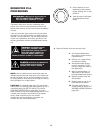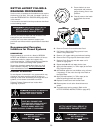
KETTLE VENTING
INSTRUCTIONS
1. Remove Access Panel from
back of main kettle console.
2.
Turn kettle ON and set temperature
control to 10, heat the empty kettle
until unit cycles off.
3. Vent kettle by pulling Valve Ring
eight to fifteen times, holding
valve open for two seconds
each time.
NOTE: If unit cycles ON, stop
venting and wait for kettle to cycle
OFF before continuing.
4. Turn kettle OFF. Add cold water
to kettle until its surface
temperature is below 100°F. The
pressure gauge needle should
be in the green zone, indicating a
vacuum in the kettle’s jacket.
5.
If needle is in the green zone then
venting was successful. If not
repeat procedure.
2
3
5
6
7
8
9
1
4
10
OFF
50
0
100
150
200
250
300
350
400
40
50
60
0
10
20
30
psi
kPa
V
E
N
T
A
I
R
50
0
100
150
200
250
300
350
400
40
50
60
0
10
20
30
psi
kPa
V
E
N
T
A
I
R
27
The following venting procedure
should be followed when the
Vacuum/Pressure Gauge needle
is in the "VENT AIR" zone:
NOTE: Check for and eliminate leaks prior to venting
(See REPAIRING LEAKS IN STEAM JACKETED KETTLE
FITTINGS on page #27).
DANGER: PRESSURE RELIEF
VALVE WILL EXHAUST HIGH
TEMPERATURE STEAM. CONTACT
WITH SKIN COULD RESULT IN
SERIOUS BURNS. KEEP FACE,
HANDS AND BODY CLEAR OF DISCHARGE.
DANGER: WORKING ON MACHINES
WITH POWER COULD RESULT IN
SEVERE ELECTRICAL SHOCK.
VACUUM LEAK TEST
PROCEDURE
If the kettle will not hold vacuum, test for leaks at:
A. Water Level Probe.
B. Pressure Relief Valve/Pressure Gauge and
connecting plumbing.
C. Boiler Drain Cap.
D. Sight Glass.
LEAK TEST PROCEDURE:
1. Heat kettle until unit cycles off.
2. Shut off power to the kettle at the fused disconnect
switch.
3. Spread Bubble Type Leak Detector over suspected
areas and watch closely for bubbles.
4. Repair areas as required.
REPAIRING LEAKS IN STEAM
JACKETED KETTLE FITTINGS
If unit will not hold a vacuum the most likely cause is a
leak at one of the fittings.
Often, the easiest way to eliminate a leak is reseal the
suspect areas.
1. Water Level Probe
Remove,clean threads, apply teflon thread sealant
and reinstall.
2. Pressure Relief Valve
A/ Inspect for signs of leaks. Replace if required.
B/ Remove, clean threads, apply teflon thread
sealant and reinstall.
3. Pressure Gauge
A/ Inspect face of gauge. If it contains moisture
on the inside of face replace.
B/ Check tightness of plumbing connection to
pressure Gauge.
3. Sight Glass
A/ Check tightness of sight glass.
B/ Replace "O" ring if required.
Pressure
Relief Valve
Access
Panel
Valve
Ring


















